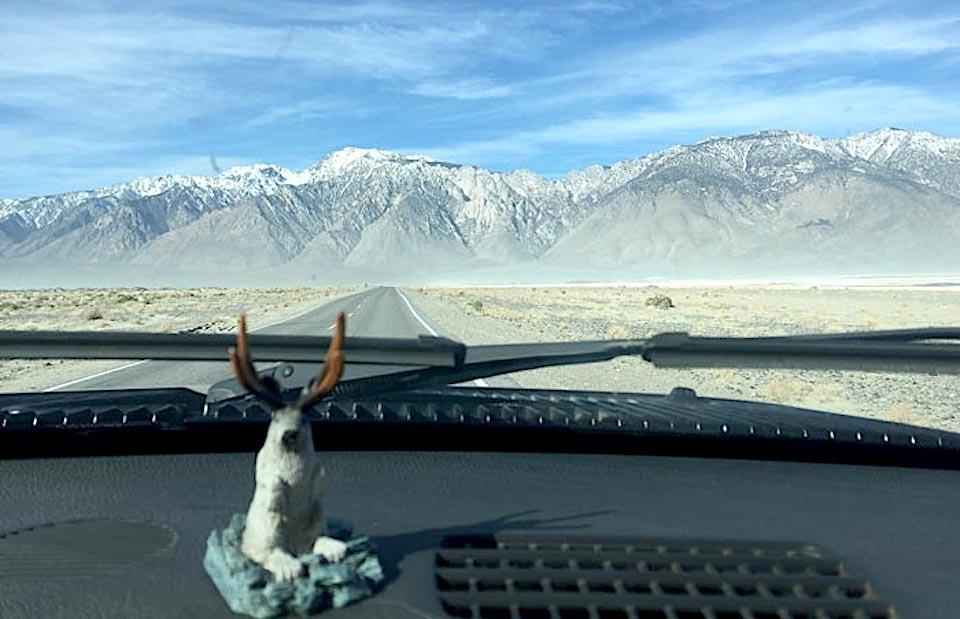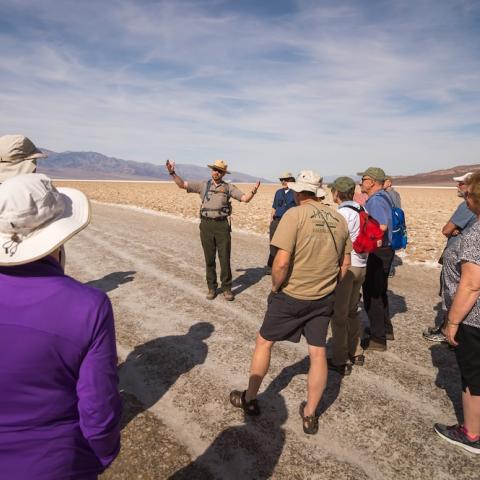
Leaving Death Valley National Park seemed simple enough, until we hit the steep grades beyond Panamint Springs/Rene Agredano
RV camping in national parks isn’t rocket science to us anymore. During our 12 years as full-time nomads we’ve done it more times than I remember. So that morning when we left Death Valley 30 minutes before sunlight heated up the Texas Spring Campground, I didn’t think twice about our exit route. Fully loaded with fresh water for a longer stay outside the park, I directed my husband to drive us westbound on Highway 190, oblivious to what lay ahead.
One hour later, as he cursed under his breath and expertly hauled our 30-foot trailer up the long, terrifying ascent from Panamint Springs, the truck overheated. I grew sick with regret when he pulled over at the Father Crowley Overlook. If only I had read the Death Valley Road Conditions web page before we left.
Highway 190
Extra long RVs and semi-trailers are not recommended on the steep, windy section west of Panamint Springs Resort.
We averted disaster that day, but now I know that no matter how many times we go RV camping in national parks, it always pays to think like RV newbies and remember these top ten tips.
Ten Things to Know About RV Camping in National Parks
1. Camp near your “Must See” activities or attractions. Even the smallest national park site in America has too many things to see and do in one brief visit. If you try to do them all, you’re missing the point of getting back to nature. Choose a couple of “Must See” attractions instead and plan your activites around them.
* Save on fuel costs and driving time. Choose the closest campground to your activities.
* Split your time between two separate campgrounds if the activities are at opposite ends of the park.
2. You’re better off with a reservation. Browse the National Park System’s reservation portal at Recreation.gov and you’ll understand how landing a precious RV campsite feels as thrilling as scoring tickets to your favorite summer music festival. Tent sites outnumber RV campsites, but here’s how you can land a spot:
* Reserve as far ahead as possible from your desired arrival date. Don’t depend on first-come, first-served campsites during peak season – unless you enjoy the stress of not knowing where you’ll stay.
* Know your RV’s height, length and width measurements before booking a campsite. The average national park RV campsite can only accommodate RVs under 30 feet. Don’t book a reservation until you know that yours will fit on the parking apron.
* Review RV campsite descriptions. If the words “full hookups” are not included, you will be dry camping without water, sewer or electric hookups.

Signs announcing hills are more important for RVers than Volkswagens/Rene Agredano
3. Do a dry camping shake-down trip. Dry-camping (aka “Boondocking”) is an art that takes practice. If you have never boondocked before, don’t wait until the big trip to try it.
* Go on a dry-camping getaway. Find a full-hookup campground near home and challenge yourself to see how long you can camp before connecting to the services when you exhaust your water supply and fill your holding tanks.
* Understand your electricity consumption. Keep track of how quickly the RV house batteries drain while you live with your “must have” appliances. Use only those you need for minimal comfort and maximum battery life.
4. Deal with the dump station blues. The better you get at dry-camping, the longer you can put off the inevitable dump station visit. Here’s how to make the experience more enjoyable.
* Use your own freshwater supply hose. Never fill your fresh water tank with a dump station hose. Someone may have cleaned their black water tank with it.
* Take a “Water Bandit” garden hose adapter along. Many national park RV dump stations lack threaded hose connections. This inexpensive device allows you to attach your freshwater hose to any unthreaded water source in order to fill your tank.
5. Plan ahead for pets. National parks are not the most pet-friendly camping destinations. If you love your pets like family but intend to enjoy trails where they are not allowed, consider leaving them at a boarding facility when you go. If that’s not an option, these national park pet tips can keep your dog or cat safe.
* Never leave your pet alone in the RV on a summer day – even if your spot has electric hookups. Your air conditioning unit can fail and put your pet at risk of heat stroke.
* Keep your pet leashed. Dangerous natural hazards like thorny plants, venomous snakes and hot pavement are huge threats in places far away from veterinary care.
* Know seasonal wildlife dangers. The day my German Shepherd was attacked by a Great Horned Owl after we inadvertently walked too close to her nest, I understood the risk of bringing him into wild places. Late spring and early summer are particularly risky for pets in the wild. New mothers are protective of their newborn offspring and won’t hesitate to harm your fur baby.
6. Study RV-friendly routes to, from, and through the park. National park roads can take you to the top of the world and burn your RV brakes out at the bottom. Many park roads are simply unsafe for RVs, like the The Zion-Mount Carmel Tunnel in Zion National Park. Completed in 1930, the one mile rock tunnel connecting Zion, Bryce and the Grand Canyon National Parks is too low and narrow for many modern RVs. Here’s how not to wreck your RV during your park visit:
* Purchase the Mountain Directory Guides to map safe RV routes to and from the park. A GPS navigation app for RVs and truckers is also helpful.
* Download a national park roads map before leaving. Inquire about your planned RV route with visitor center staff.
* Buy RV Roadside Emergency Coverage. National parks are usually far away from RV repair shops and one RV tow may cost more than your entire trip. Get a RV-specific plan to protect your wallet in worst case scenarios.

The Furnace Creek Campground at Death Valley National Park would be a good place to practice dry camping, as there are full hookups available if you don't quite have the knack down/Rene Agredano
7. Practice your RV maneuvering skills. Most of America’s national park roads and campgrounds were built decades before the average RV size increased to 42 feet long. From steep downhill grades to narrow interior roads and back-in RV sites lodged between boulders, you’re sure to experience at least one crazy obstacle.
* Learn how to back up, drive on mountain roads, and avoid overhead hazards. A pre-trip weekend RV driving course will help, and the tuition is cheaper than paying for an accident.
* Watch YouTube videos for how to back up a trailer or motorhome. Practice in a parking lot near home.
* Take an online RV driver education course through Escapees RV Club. You’ll get acquainted with basic RV systems and learn driving tips every RVer needs to know.
8. Bring enough supplies. If you need to buy food, fuel and provisions inside or just outside park gates, you’ll pay a premium. Plan ahead to minimize your costs and day trips to town.
* Stick to a meal menu. Think about the easiest dry-camping meals you can make while living without RV hookups. The fewer the dishes, pots, and pans you need to wash, the more water you will conserve.
* Stock the pantry with non-refrigerated food. Breakfast cereals, juice and milks in aseptic packaging, dry fruit, and snack bars are all good choices.
* Pack extra consumables. Paper towels and plates are some of the highest priced necessities you'll find anywhere near national parks, and you’ll use them faster to save water while dry-camping.

A first time RVer, and not embarrassed to admit it/Rene Agredano 960
9. Drive extra defensively in the park. Visitor overcrowding and poor driving skills all contribute to wildlife-vehicle collisions in national parks, but you can take steps to avoid becoming another statistic.
* Drive slower than posted speed limits. On average, 100 large, iconic animals are killed each year in places like Yellowstone because speeding drivers don’t react in time. Allow yourself extra stopping distance.
* Use roadside turnouts and drive in the slow lane. Nothing fuels road rage faster than RVs holding up traffic.
10. Be a considerate camper. From outdoor kitchens to exterior home theaters, we RVers enjoy the comforts of home. But please don’t let the noise from your favorite RV luxuries annoy your neighbors.
* Use your generator sparingly. Don’t contribute to air and noise pollution.
* Minimize TV and stereo sound. Noise travels in the wilderness.
* Respect dark skies. Turn off outdoor RV lights when you retire for the night.
Nature is an RVer’s Best Teacher
More RVers are on the road than ever before, and many of us enjoy visiting national parks. But obtaining a peak-season campsite reservation is only half the challenge: being kind, patient, and aware of other campers and wildlife is the other. In the era of park overcrowding, follow these simple tips when RV camping in national parks to ensure a more pleasurable experience for everyone.




 Support Essential Coverage of Essential Places
Support Essential Coverage of Essential Places







Comments
Any advice for non-peak season? Still need reservations?
Commercialization of National Parks will be the end of my visiting OUR National Parks. Something I've enjoyed doing for more years tham most are alive. America has plenty of places to go commercial if you want that. We don't. I go for tranquility and beautiful scenery. I can only imagine what will become of Park Camping and areas if changed.
Just saw your article, good tips, but for 1st timers use Cruise America. You learn everything before you turn the key, company policy. Sam and Mary Phillips.
my husband and i are purchasing a 40ft motor home and have farmed and ranched and pulled 40 ft fifth wheels but are wanting advice on travel and rv sites in U.S. Ordered the east and west mountain trail maps. any recommendations would be appreciated. 2016 monaco is what we will be in. we are so excited but feel so ignorant.
Great info,really appreciate your time and effort thank you